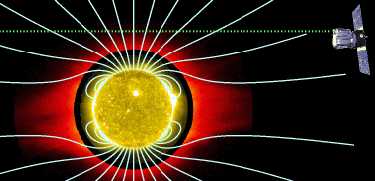 |
 |

|
| Artist's conception of SOHO in space | UVCS in the lab before it was attached to the spacecraft | SOHO prior to launch with UVCS displayed in front (gold cylinder) |
UVCS is the Ultraviolet Coronagraph Spectrometer, an instrument flying on the Solar and Heliospheric Observatory (SOHO) spacecraft. SOHO, a joint mission between NASA and the European Space Agency, was launched in December 1995 with the goal of solving some long-standing mysteries about our Sun.
SOHO orbits the Sun at the L-1 Lagrange point between the Earth and the Sun, which gives it an unobstructed, 24-hour-a-day view of the Sun and its surrounding layers of ionized gas. SOHO continues to be an extremely successful mission, and we are continuing to learn more about the Sun as we see more of its 11-year solar cycle with SOHO.
Click on the small images below for larger images:
 |
 |

|
| Artist's conception of SOHO in space | UVCS in the lab before it was attached to the spacecraft | SOHO prior to launch with UVCS displayed in front (gold cylinder) |
The goal of the UVCS mission is to provide a detailed description of the extended solar corona that can be used to address a broad range of scientific questions regarding the heating of the corona and the generation of the solar wind. UVCS makes measurements of the solar corona between 1.5 and 10 solar radii (measured from Sun center), which is the range of heights where the solar wind particles undergo most of their acceleration. The image below shows a typical "line of sight" observed by UVCS through the extended corona. The yellow image is the disk of the Sun in ultraviolet light (as seen by the EIT instrument on SOHO). This light is blocked out by UVCS, which only sees the red parts in the image below.

The reason that an instrument like UVCS is needed to measure the properties of the ionized gas in the extended solar corona can be understood by breaking down the UVCS acronym:
Traditionally, total solar eclipses have been the only way to block out enough of the light of the Sun to see the corona. In the 1930s, though, Bernard Lyot of France invented the coronagraph by placing an opaque, circular "occulting disk" in the middle of the light-path of a solar-viewing telescope, to take the place of the Moon. In the 1970s, John Kohl and colleagues at the Smithsonian Astrophysical Observatory developed coronagraphs that can view solar ultraviolet light, and flew these "UVCS prototypes" on rockets and eventually on the Shuttle-carried Spartan 201 payload in the 1990s. UVCS and its earlier relatives use not one, but two occulting surfaces, positioned at different places along the light path, to block out as much of the light from the solar disk as possible.
The spectrum of light contains much more information about the ionized gas, or plasma, than just images could convey. This is especially true for the extended solar corona that UVCS observes. Scientists are accustomed to thinking about rather high-density gases and plasmas, for which there are very frequent collisions between the various atoms, ions, and electrons. These collisions create a state of equilibrium between the different types of particles, which undergo frequent enough collisions to share their energy (thus all "agreeing" upon a common flow speed and temperature). But for the very low-density corona, collisions are so infrequent that each type of particle can have its own independent flow speed and temperature, depending on what process is doing the accelerating and heating! These properties are revealed in spectral lines, i.e., sharp features in the spectrum that arise when a bound electron in an atom or ion drops down from an excited energy level to a level with lower energy. This energy is released in photons of a specific frequency, and the Doppler shifts of these photons allow us to probe the motions of each type of atom or ion in the corona.
Other pages on this web site, as well as many of the links highlighted above, provide much more information about UVCS, how it works, and what kinds of scientific discoveries it has made.
You can continue on to a more detailed UVCS tutorial called "Follow the Photons" that takes you all the way through the UVCS instrument and shows how ultraviolet light starts at the Sun and ends up at the UVCS detectors.